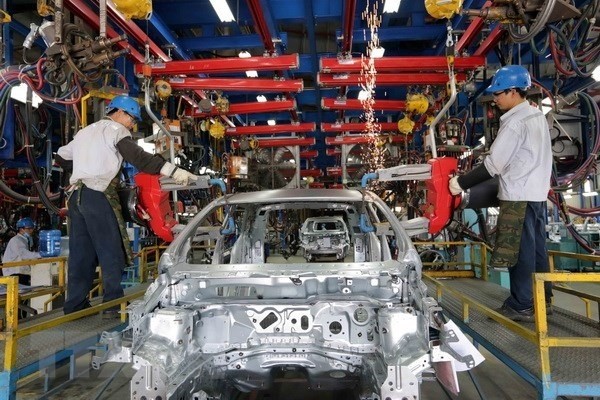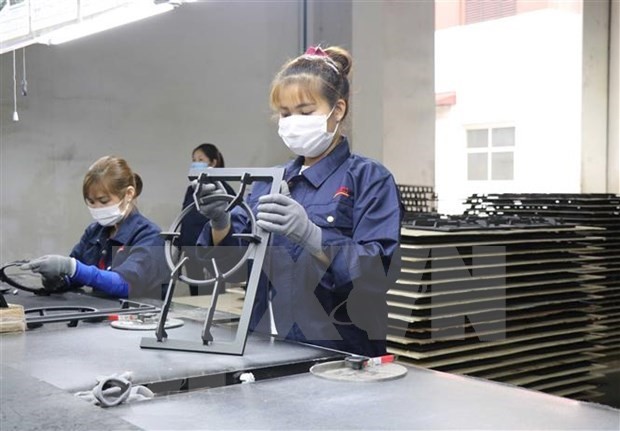Vietnam To Attract 30 Billion USD in FDI in 2021
Vietnam may attract about 30 billion USD in foreign direct investment (FDI) in 2021, posting a year-on-year rise of 2 percent, economists forecast, pointing to positive signs in FDI attraction in the first eight months of 2021 despite the complexities of COVID-19, according to VNA.
 |
| At an assembly workshop of Ford Vietnam CO., Ltd in Hai Duong province.(Photo: VNA) |
According to the Ministry of Planning and Investment, foreign investors channelled 19.12 billion USD into the country in January-August, equalling nearly 98 percent of the same period last year, with several multi-billion USD projects.
Singaporean investors poured over 3.1 billion USD into the Long An LNG power plants No 1 and 2 while the O Mon 2 thermal power plant in Can Tho city invested by Japan received 1.31 billion USD in the period. The LG Display project in Hai Phong city has received additional investment twice this year, with 750 million USD in February and 1.4 billion USD in August.
Despite social distancing measures to curb the spread of COVID-19, the country’s FDI inflow in the first eight months only saw a slight decline of 2.1 percent against the same period last year, said Nguyen Van Toan, deputy head of the Vietnam’s Association of Foreign Invested Enterprises.
Of note, new registered capital surged 16.3 percent and disbursement of FDI capital hit 11.58 billion USD, up 2 percent.
Speaking with Cong Thuong (Industry and Trade) newspaper, Phan Huu Thang, former head of the Vietnam Trade Promotion Agency (Vietrade) at the Ministry of Industry and Trade, voiced his belief that FDI inflow into Vietnam may still reach about 30 billion USD this year.
To address current difficulties facing foreign investors when they want to enter the country to study investment possibilities or to implement investment projects, the Government and relevant ministries and agencies are urged to consider reducing quarantine period for those who have been fully vaccinated and hold a negative COVID-19 testing certificate.
Vietnam’s FDI inflows plunge 11.1 percent in seven months
 |
| Production at a factory of Vietnam Bright International Co., Ltd. in Bac Ninh's Thuan Thanh II Industrial Park. (Photo: VNA) |
Vietnam raked in 16.7 billion USD in foreign direct investment (FDI) in the first seven months of 2021, down 11.1 percent from the same period last year, data from the Ministry of Planning and Investment (MPI) shows.
This is the biggest fall in FDI inflows since the COVID-19 pandemic broke out again in the country in late April, wreaking havoc on multiple industrial parks in the northern provinces of Bac Giang and Bac Ninh.
Earlier, FDI inflows declined 2.6 percent year-on-year in the first half of the year, after it edged up 0.8 percent in the January-May period.
According to the MPI’s Foreign Investment Agency, of the 7-month figure, 10.13 billion USD came from 1,006 newly-registered projects, up 7 percent year-on-year.
Some 4.54 billion USD was added to 561 existing projects, representing a year-on-year decrease of 3.7 percent. Capital contribution and share purchases by foreign investors dropped by 55.8 percent to 2.05 billion USD.
Economists believed that the COVID-19 pandemic is taking toll on Vietnam’s FDI attraction. The fourth coronavirus wave has knocked the confidence of European businesses, with the EuroCham Business Climate Index (BCI) falling almost 30 points to 45.8 in the second quarter of this year.
Despite the contraction, the FDI disbursement slightly rose by 3.8 percent from a year earlier to 10.5 billion USD.
The largest proportion of the seven-month FDI, 7.9 billion USD or 47.2 percent, landed in processing and manufacturing, followed by electricity production and distribution, with 5.49 billion USD or 32.8 percent.


